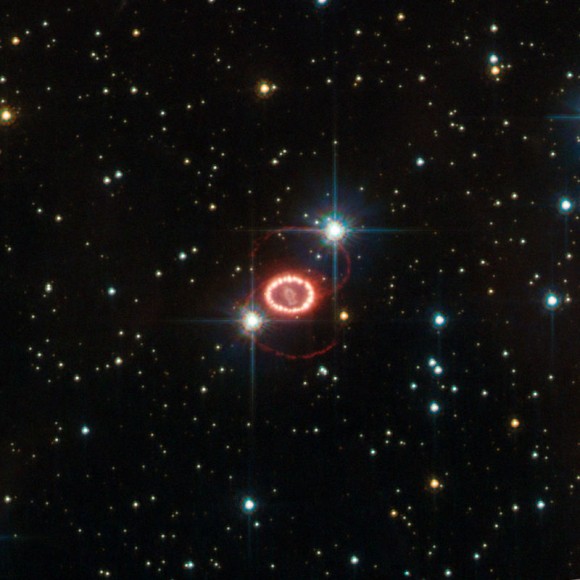- Earth has undergone at least 5 mass extinction events. While scientists know some of the causes – such as the meteor impact – others are still unclear.
- The late Devonian and Ordovician extinctions happened 372 and 445 million years ago, respectively, killing off 70% and 85% of earthly life.
- The new study says these extinctions were likely due to supernova explosions. The nearby exploding stars would have stripped the protective ozone from our atmosphere.
The Royal Astronomical Society published this original story on March 13, 2025. Edits by EarthSky.
Supernovas led to at least 2 mass extinctions
At least two mass extinction events in Earth’s history were likely caused by the devastating effects of nearby supernova explosions. That’s according to a new study by researchers at Keele University in England. The researchers said these super-powerful blasts – caused by the death of a massive star – might have previously stripped our planet’s atmosphere of its ozone, sparked acid rain and exposed life to harmful ultraviolet radiation from the sun. They believe a supernova explosion close to Earth could be to blame for both the late Devonian and Ordovician extinction events, which occurred 372 and 445 million years ago respectively.
The Ordovician extinction killed 60% of marine invertebrates at a time when life was largely confined to the sea. Meanwhile, the late Devonian wiped out around 70% of all species. Plus, it led to huge changes in the kind of fish that existed in our ancient seas and lakes.
Past research has failed to identify a clear cause for either event. But scientists think they are linked to the depletion of Earth’s ozone layer, possibly due to a supernova.
The researchers published their results on March 13, 2025, in the peer-reviewed Monthly Notices of the Royal Astronomical Society. The new study found that the rate supernovas occur near our planet is consistent with the timings of both mass extinctions.
The authors say it is:
a great illustration for how massive stars can act as both creators and destructors of life.
That’s because supernovas are also known to spread the heavy elements that help form and support life across the universe.
2025 EarthSky lunar calendar is available now. A unique and beautiful poster-sized calendar with phases of the moon for every night of the year. Get yours today!
Supernovas and extinctions
Supernovas occur when massive stars reach the ends of their lives. They run out of fuel, cool off and then collapse under the pressure of gravity. The explosions are the biggest humans have ever seen.
Lead author Alexis Quintana, formerly from Keele University and now at the University of Alicante, said:
Supernova explosions bring heavy chemical elements into the interstellar medium, which are then used to form new stars and planets. But if a planet, including the Earth, is located too close to this kind of event, this can have devastating effects.
Co-author Nick Wright from Keele University added:
Supernova explosions are some of the most energetic explosions in the universe. If a massive star were to explode as a supernova close to the Earth, the results would be devastating for life on Earth. This research suggests that this may have already happened.
The research
The researchers came to their conclusion after carrying out a census of massive stars within a kiloparsec (around 3,260 light-years) of the sun.
They studied the distribution of these massive stars to learn more about how star clusters and galaxies form. And they used the Milky Way itself and the rate at which these stars form in our galaxy as a benchmark.
This census allowed the researchers to calculate the rate at which supernovas occur within the galaxy. This is important for observations of supernovas, and the production of supernova remnants and massive stellar remnants such as black holes and neutron stars throughout the universe.
The data is also useful for future development of gravitational wave detectors, which are a useful tool for scientists studying the structure and origins of the universe.

The rate of supernovas that Earth should experience
The research team calculated the supernova rate within 20 parsecs of the sun, or approximately 65 light-years. Then they compared this with the approximate rate of mass extinction events on Earth that have previously been attributed to nearby supernovas. This excludes extinction events linked to other factors such as asteroid impacts or the ice ages.
Comparing these data sets, the experts found their research supported the theory that a supernova explosion was responsible for both the late Devonian and Ordovician extinction events. These are two of the five known mass extinctions in Earth’s history. Wright explained:
We calculated the supernova rate close to Earth and found it to be consistent with the rate of mass extinction events on our planet that have been linked to external forces such as supernovas.
Could it happen again … and soon?
Astronomers believe about one or two supernovas (or fewer) occur each century in galaxies like the Milky Way. But the good news is there are only two nearby stars which could go supernova within the next million years or so: Antares and Betelgeuse.
However, both of these are more than 500 light-years away from us. And computer simulations suggest a supernova at that distance from Earth likely wouldn’t affect our planet.
Bottom line: Researchers said that two of Earth’s five mass extinction events – the late Devonian and late Ordovician extinctions – were likely the result of nearby supernovas destroying Earth’s ozone layer.
Source: An optically led search for kilonovae to z0.3 with the Kilonova and Transients Programme (KNTraP)
Via Royal Astronomical Society